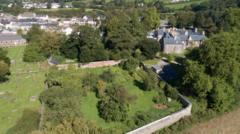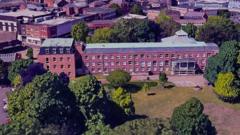How Will £1.2M Revive the Hidden Walled Garden?

A Historic Transformation: The 18th Century Walled Garden's Revival
Nestled in the heart of Abergwili, Camarthenshire, a historic 18th-century walled garden is on the brink of a significant transformation. Once a thriving source of fruits and vegetables for the Bishop of St Davids, this garden has remained largely inaccessible for decades. Thanks to a generous £1.2 million funding boost from the National Lottery Heritage Fund, the Tywi Gateway Trust is embarking on a project that aims to breathe new life into this hidden gem. The plans include the reconstruction of three historic glasshouses, a gardener's bothy, and the establishment of a vibrant space for community and educational events.
The Significance of the Walled Garden
The walled garden, often described as a "secret garden," has a rich history that dates back to the 18th century. For years, it served as a crucial source of produce for the Bishop of St Davids. Its stone walls not only provided protection from the elements but also created a secluded environment where various plants could thrive. However, due to neglect and overgrowth, access to this historic site has been severely limited.
Vision for the Restoration
Project manager Louise Austin emphasizes the importance of combining historical reverence with contemporary relevance in this restoration project. The goal is not just to recreate what once was but to forge a living space that resonates with both past and present. By doing so, the project aims to foster a connection for visitors and volunteers, allowing them to draw inspiration from the garden's rich history.
Rebuilding History: The Glasshouses and Gardeners’ Bothy
Among the most exciting aspects of the restoration are the plans to rebuild three historic glasshouses and a gardener’s bothy or shelter. These structures will serve as focal points for the garden, housing plants and educational displays while providing a comfortable space for gardeners and visitors alike. The glasshouses are particularly significant as they represent the innovation of the time, showcasing the techniques used for cultivating exotic plants.
Community Engagement and Educational Opportunities
This revitalized garden is set to become a hub for community engagement and education. The Tywi Gateway Trust envisions hosting various events, workshops, and performances that will bring people together. By creating a "living archive" of the garden’s history, the project will ensure that the stories of those who worked and thrived in the garden are preserved and celebrated. This aspect is crucial for educating future generations about the importance of horticulture and local history.
A Glimpse into the Past: The Diaries of Gwenonwy Davies
One remarkable feature of the garden's history is captured in the handwritten diaries of Gwenonwy Davies, the eldest daughter of Bishop John Owen. These diaries reveal that the garden was once a place of experimentation and diversity, growing exotic fruits like pineapples and grapes, as well as stunning plants such as orchids and maidenhair ferns. These accounts not only highlight the agricultural practices of the time but also the personal connections that individuals had with the garden.
Restoration Efforts: From Rubbish to Riches
Since 2018, the Tywi Gateway Trust has mobilized volunteers to clear debris and overgrowth from the garden. This grassroots effort has included planting new fruit trees and restoring the garden to a state where it can again be productive. The commitment of the volunteers showcases the community's dedication to resurrecting this historical site, transforming it from a forgotten space into a thriving garden once more.
Funding the Future: A Collaborative Effort
The overall project has garnered impressive financial backing, totaling around £2 million. This includes £300,000 from the Welsh government's Community Facilities programme, £150,000 from the Garfield Weston Foundation, £100,000 from a heritage philanthropist, and £20,000 from the Pilgrim Trust. These funds are crucial for ensuring that the restoration is not just a cosmetic fix but a comprehensive revitalization that honors the garden's history while making it accessible for future generations.
Emphasizing the Garden's Soul
Betsan Caldwell, chair of the Tywi Gateway Trust, expresses the excitement of sharing not only the physical beauty of the garden but also its "very soul." This sentiment resonates with the goal of creating a space that embodies the stories, skills, and quiet wisdom of those who once nurtured this land. By fostering a deeper connection with the garden, the trust hopes to inspire visitors and volunteers alike, allowing them to glean insights that can enrich their own lives.
Conclusion
The restoration of the historic 18th-century walled garden in Abergwili is more than just an aesthetic endeavor; it is a journey toward reconnecting the community with its history, nature, and each other. As the project unfolds, it promises to create a vibrant space that celebrates the past while paving the way for future generations to appreciate and learn from this magnificent garden. The excitement surrounding the transformation is palpable, and it raises an intriguing question: how will this renewed space inspire the community in the years to come?
Frequently Asked Questions
What types of events will be held in the restored walled garden?
The restored walled garden will host a variety of community events, educational workshops, and public performances aimed at engaging visitors and fostering a connection to the garden's history.
How did the garden contribute to the local history of Abergwili?
Historically, the garden served as a vital source of produce for the Bishop of St Davids, showcasing agricultural practices and exotic plant cultivation techniques from the 18th century onwards.
What is the significance of the diaries of Gwenonwy Davies?
The diaries provide valuable insights into the garden's history, detailing the types of plants that were cultivated and reflecting the personal experiences of those who lived and worked in the garden.
How can the community get involved in the restoration project?
Community members can participate as volunteers, attending events, and contributing to the ongoing efforts to maintain and nurture the garden.
What does the term 'living archive' refer to in the context of the project?
A 'living archive' refers to the collection of stories, skills, and histories of individuals who have contributed to the garden's legacy, which will be preserved and shared with future generations.
The transformation of this historic walled garden offers a unique opportunity to bridge the past and present. As the community comes together to restore and celebrate this cherished space, one has to wonder: what future memories will be created in this beautiful garden? #WalledGarden #CommunityRestoration #HistoricPreservation
Published: 2025-07-30 11:20:17 | Category: wales



